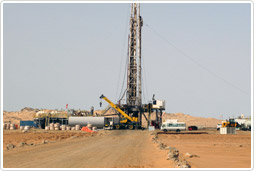Exploration Drilling & Formation Appraisal
The following provides an example of some of the text that can be included on the drilling page. Links to related reports can be provided on the left side of the page.
In the early stages of development, exploration wells are drilled. In the event of a find, formation appraisal may be carried out to determine the volume and production rate of hydrocarbons that may possibly be recovered.
Environmental Risks from Drilling:
- Generation of hazardous waste such as: drilling muds, used chemicals etc.;
- Generation of non hazardous waste such as, packaging, plastics and drums;
- Potential for chemicals to enter into the environment;
- Disturbance to the natural features of the landscape;
- Decrease in local air quality from dust and exhaust emissions;
- Atmospheric emissions of CO, CO2, SO2, NOx, VOCs, Hydrocarbons, PM10 from generators, drilling machinery, vehicles and flaring;
- Noise emissions from drilling platform, vehicles and generators;
- Ground water consumption from drilling;
- Potential risks of hazardous materials to ecology
- Etc.
Mitigation:
- A non-hazardous and hazardous waste management plan should be prepared to be implemented by field personnel and the waste management contractor;
- Storage of wastes should be as per the waste management plan and the MSDS relating to particular materials;
- Staff, including Company personnel and Contractors’ personnel, should be trained in the appropriate use and storage requirements for all materials;
- Staff should be trained in chemical spill containment procedures.
- Company will define a pit closure and site restoration procedure to be followed once drilling at each site has been completed;
- Ambient air quality should be monitored and emission calculations conducted;
- Dust suppression should be carried out along active site roads;
- Driving should only be permitted on demarcated roads and routes;
- To conserve resources, water quality and quantity should be monitored closely.
- Etc.
Chemical Handling and Management
In order to reduce the risk of spills and releases to the environment and to ensure the protection of personnel working with the chemicals, a chemical handling and management standard should be developed for each operation.
The chemical management plan should detail the minimum level of care required for the storage of chemicals.
© 2012 iEMS. | Working in conjunction with Invicta - Planning services to the Oil and Gas Industry.













